Analysis of BPH Energy Ltd: Industry, SWOT, and Financials
VerifiedAdded on 2019/11/20
|7
|862
|165
Report
AI Summary
This report provides an in-depth analysis of BPH Energy Ltd, an Australian biotechnology company. It begins with a company background and explores the characteristics of the biotechnology industry, highlighting factors like high investment needs, long product lifecycles, and inherent risks. The report examines external factors affecting the company, such as interest rates and governmental regulations. It outlines benchmarks for the company, including brand maintenance and global expansion. A product life cycle analysis is presented, detailing the research and development, commercialization, and maturity phases. A SWOT analysis is provided, along with strategies to address competition in marketing, production, and governance. The report includes ratio analysis, focusing on the current and debt-equity ratios, along with the return on equity. It also discusses financial and non-financial implications, concluding with opportunities for innovation and expansion. References are provided to support the analysis.
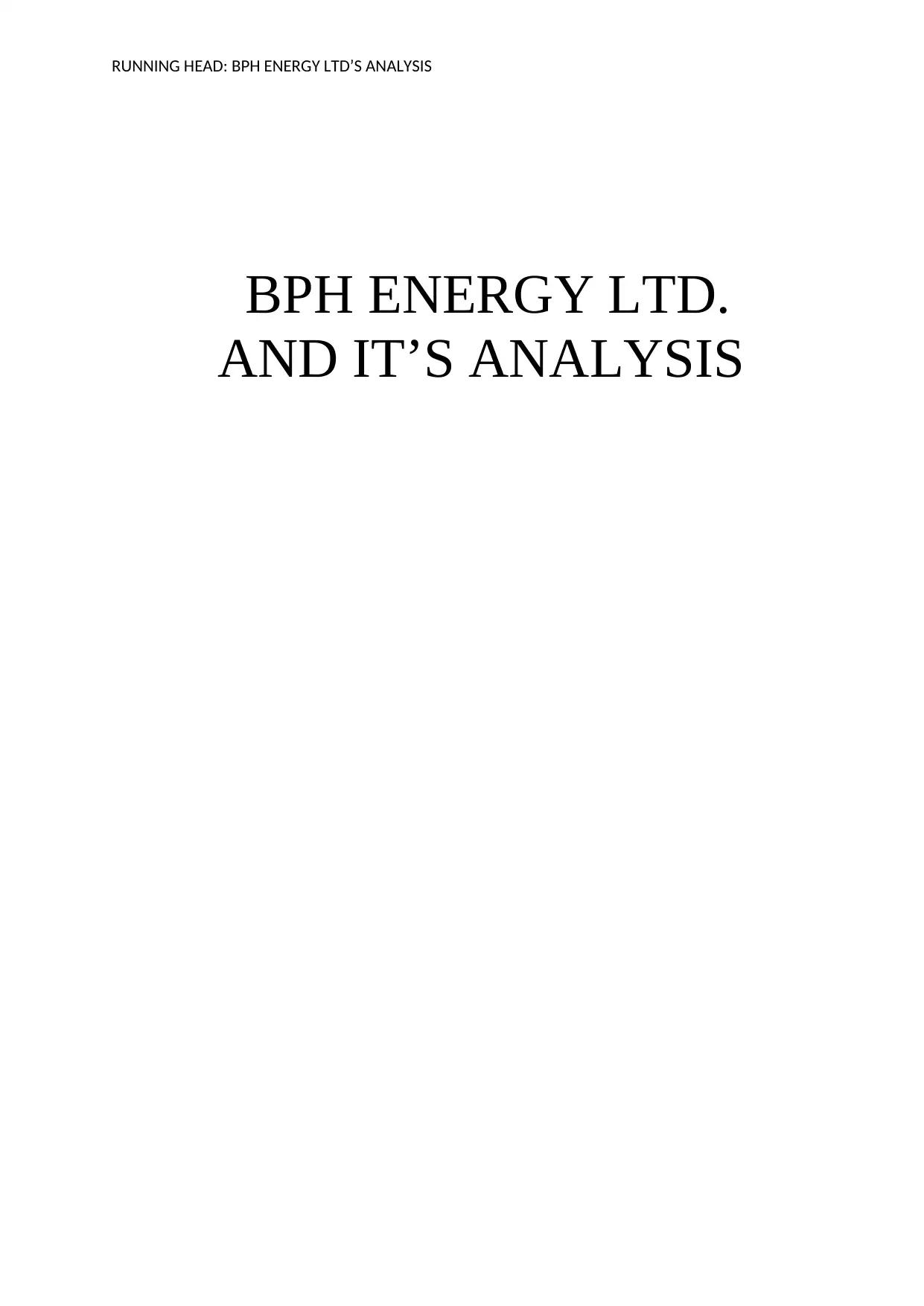
RUNNING HEAD: BPH ENERGY LTD’S ANALYSIS
BPH ENERGY LTD.
AND IT’S ANALYSIS
BPH ENERGY LTD.
AND IT’S ANALYSIS
Paraphrase This Document
Need a fresh take? Get an instant paraphrase of this document with our AI Paraphraser
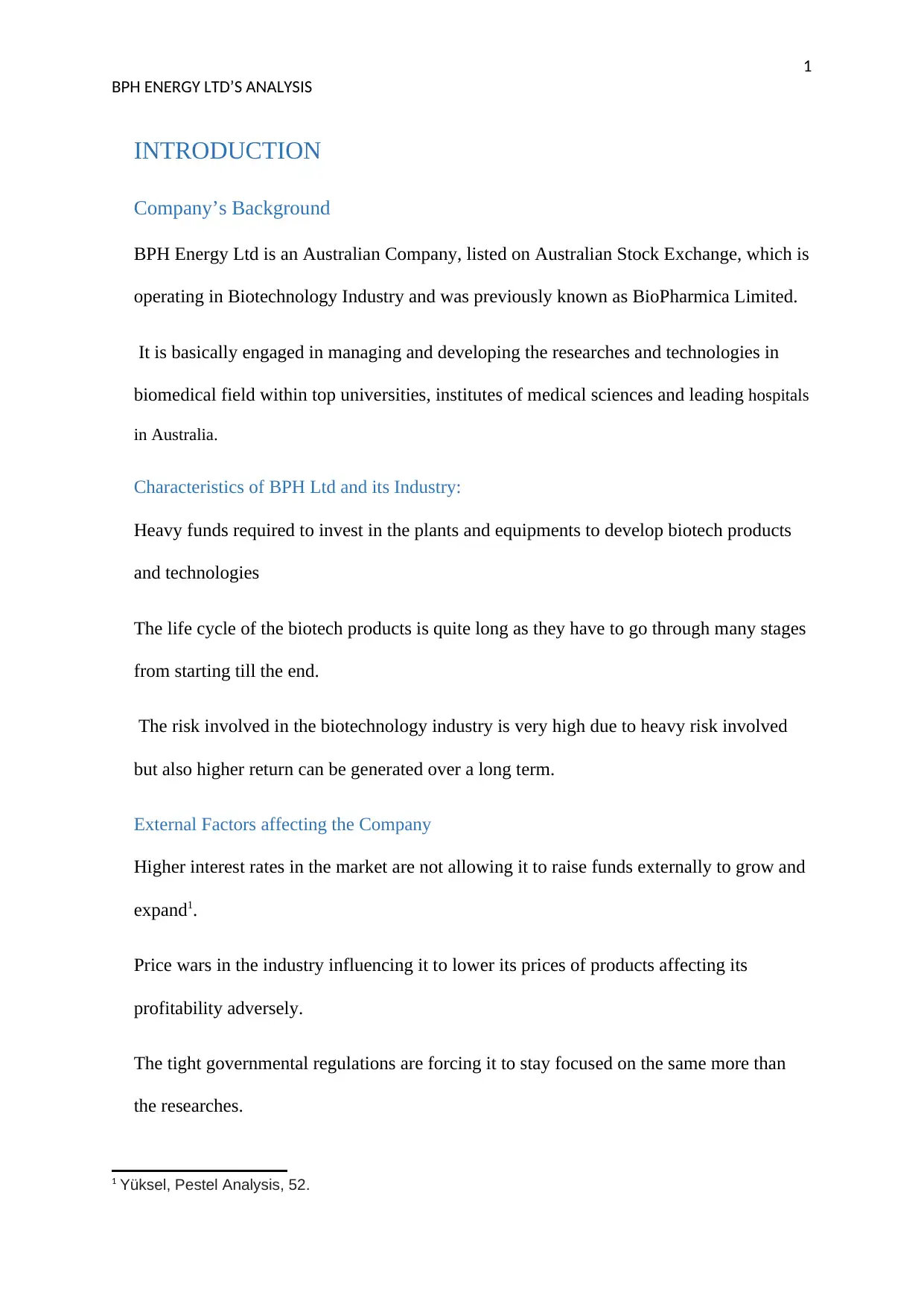
1
BPH ENERGY LTD’S ANALYSIS
INTRODUCTION
Company’s Background
BPH Energy Ltd is an Australian Company, listed on Australian Stock Exchange, which is
operating in Biotechnology Industry and was previously known as BioPharmica Limited.
It is basically engaged in managing and developing the researches and technologies in
biomedical field within top universities, institutes of medical sciences and leading hospitals
in Australia.
Characteristics of BPH Ltd and its Industry:
Heavy funds required to invest in the plants and equipments to develop biotech products
and technologies
The life cycle of the biotech products is quite long as they have to go through many stages
from starting till the end.
The risk involved in the biotechnology industry is very high due to heavy risk involved
but also higher return can be generated over a long term.
External Factors affecting the Company
Higher interest rates in the market are not allowing it to raise funds externally to grow and
expand1.
Price wars in the industry influencing it to lower its prices of products affecting its
profitability adversely.
The tight governmental regulations are forcing it to stay focused on the same more than
the researches.
1 Yüksel, Pestel Analysis, 52.
BPH ENERGY LTD’S ANALYSIS
INTRODUCTION
Company’s Background
BPH Energy Ltd is an Australian Company, listed on Australian Stock Exchange, which is
operating in Biotechnology Industry and was previously known as BioPharmica Limited.
It is basically engaged in managing and developing the researches and technologies in
biomedical field within top universities, institutes of medical sciences and leading hospitals
in Australia.
Characteristics of BPH Ltd and its Industry:
Heavy funds required to invest in the plants and equipments to develop biotech products
and technologies
The life cycle of the biotech products is quite long as they have to go through many stages
from starting till the end.
The risk involved in the biotechnology industry is very high due to heavy risk involved
but also higher return can be generated over a long term.
External Factors affecting the Company
Higher interest rates in the market are not allowing it to raise funds externally to grow and
expand1.
Price wars in the industry influencing it to lower its prices of products affecting its
profitability adversely.
The tight governmental regulations are forcing it to stay focused on the same more than
the researches.
1 Yüksel, Pestel Analysis, 52.
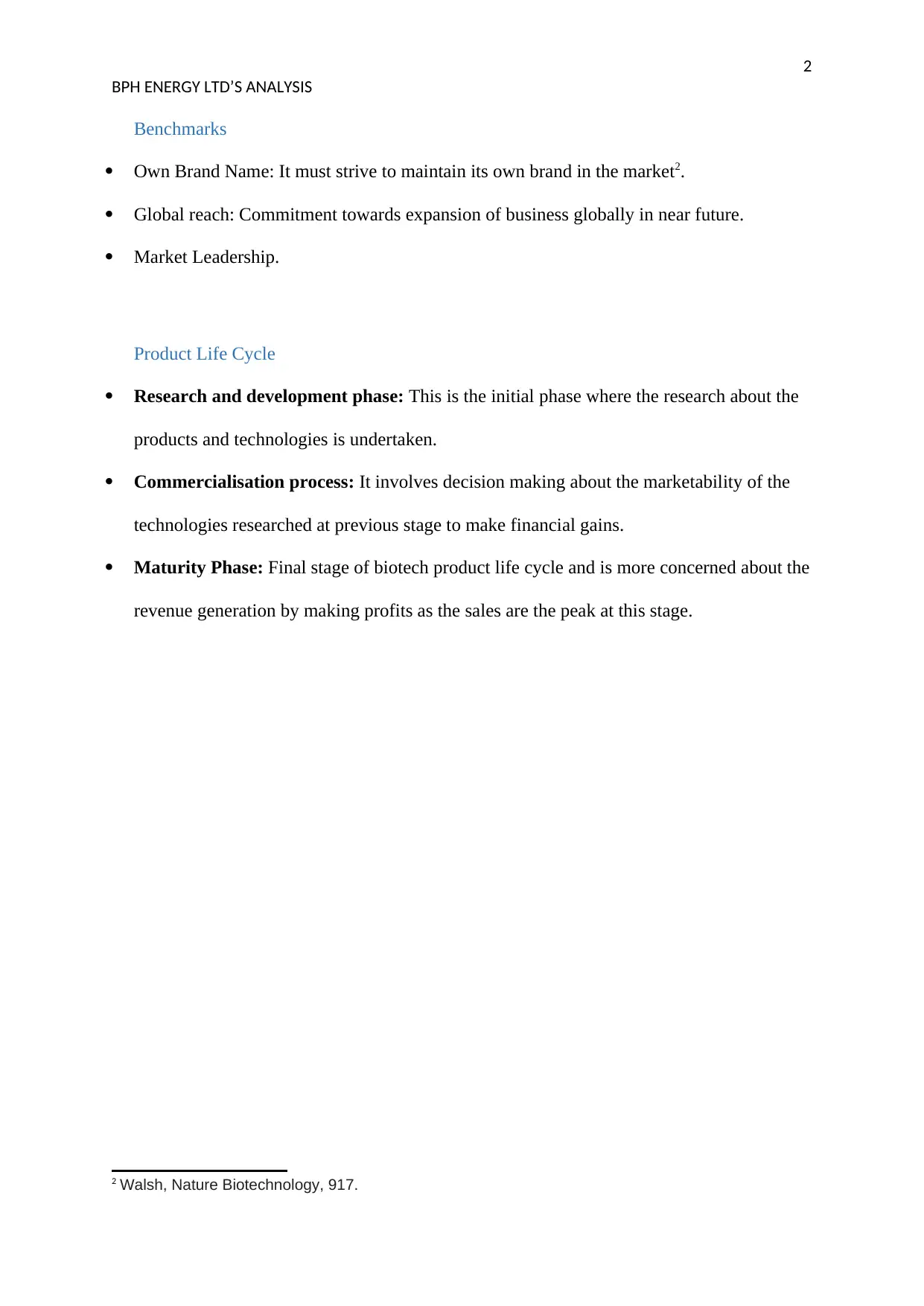
2
BPH ENERGY LTD’S ANALYSIS
Benchmarks
Own Brand Name: It must strive to maintain its own brand in the market2.
Global reach: Commitment towards expansion of business globally in near future.
Market Leadership.
Product Life Cycle
Research and development phase: This is the initial phase where the research about the
products and technologies is undertaken.
Commercialisation process: It involves decision making about the marketability of the
technologies researched at previous stage to make financial gains.
Maturity Phase: Final stage of biotech product life cycle and is more concerned about the
revenue generation by making profits as the sales are the peak at this stage.
2 Walsh, Nature Biotechnology, 917.
BPH ENERGY LTD’S ANALYSIS
Benchmarks
Own Brand Name: It must strive to maintain its own brand in the market2.
Global reach: Commitment towards expansion of business globally in near future.
Market Leadership.
Product Life Cycle
Research and development phase: This is the initial phase where the research about the
products and technologies is undertaken.
Commercialisation process: It involves decision making about the marketability of the
technologies researched at previous stage to make financial gains.
Maturity Phase: Final stage of biotech product life cycle and is more concerned about the
revenue generation by making profits as the sales are the peak at this stage.
2 Walsh, Nature Biotechnology, 917.
⊘ This is a preview!⊘
Do you want full access?
Subscribe today to unlock all pages.

Trusted by 1+ million students worldwide
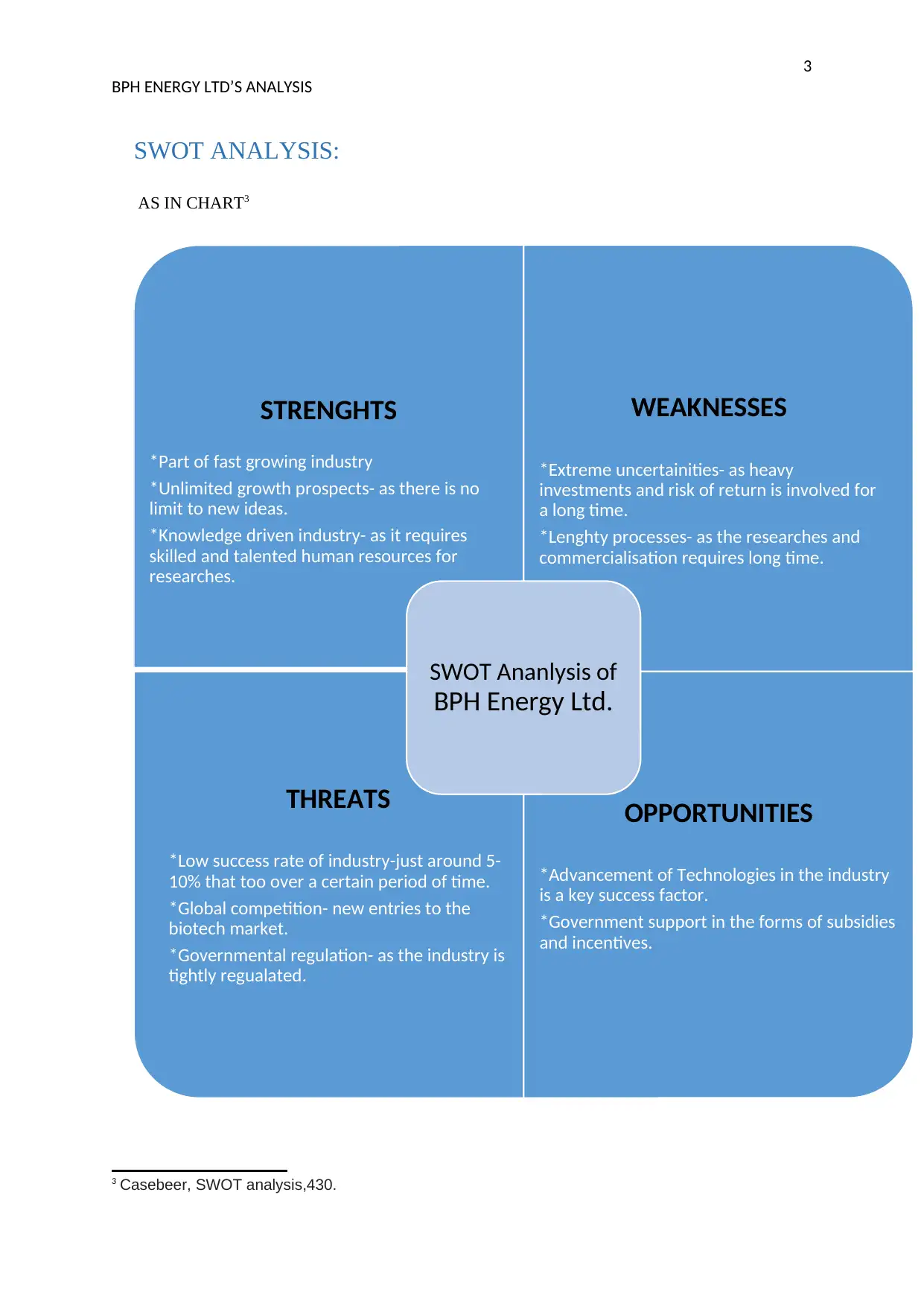
3
BPH ENERGY LTD’S ANALYSIS
SWOT ANALYSIS:
AS IN CHART3
3 Casebeer, SWOT analysis,430.
STRENGHTS
*Part of fast growing industry
*Unlimited growth prospects- as there is no
limit to new ideas.
*Knowledge driven industry- as it requires
skilled and talented human resources for
researches.
WEAKNESSES
*Extreme uncertainities- as heavy
investments and risk of return is involved for
a long time.
*Lenghty processes- as the researches and
commercialisation requires long time.
THREATS
*Low success rate of industry-just around 5-
10% that too over a certain period of time.
*Global competition- new entries to the
biotech market.
*Governmental regulation- as the industry is
tightly regualated.
OPPORTUNITIES
*Advancement of Technologies in the industry
is a key success factor.
*Government support in the forms of subsidies
and incentives.
SWOT Ananlysis of
BPH Energy Ltd.
BPH ENERGY LTD’S ANALYSIS
SWOT ANALYSIS:
AS IN CHART3
3 Casebeer, SWOT analysis,430.
STRENGHTS
*Part of fast growing industry
*Unlimited growth prospects- as there is no
limit to new ideas.
*Knowledge driven industry- as it requires
skilled and talented human resources for
researches.
WEAKNESSES
*Extreme uncertainities- as heavy
investments and risk of return is involved for
a long time.
*Lenghty processes- as the researches and
commercialisation requires long time.
THREATS
*Low success rate of industry-just around 5-
10% that too over a certain period of time.
*Global competition- new entries to the
biotech market.
*Governmental regulation- as the industry is
tightly regualated.
OPPORTUNITIES
*Advancement of Technologies in the industry
is a key success factor.
*Government support in the forms of subsidies
and incentives.
SWOT Ananlysis of
BPH Energy Ltd.
Paraphrase This Document
Need a fresh take? Get an instant paraphrase of this document with our AI Paraphraser
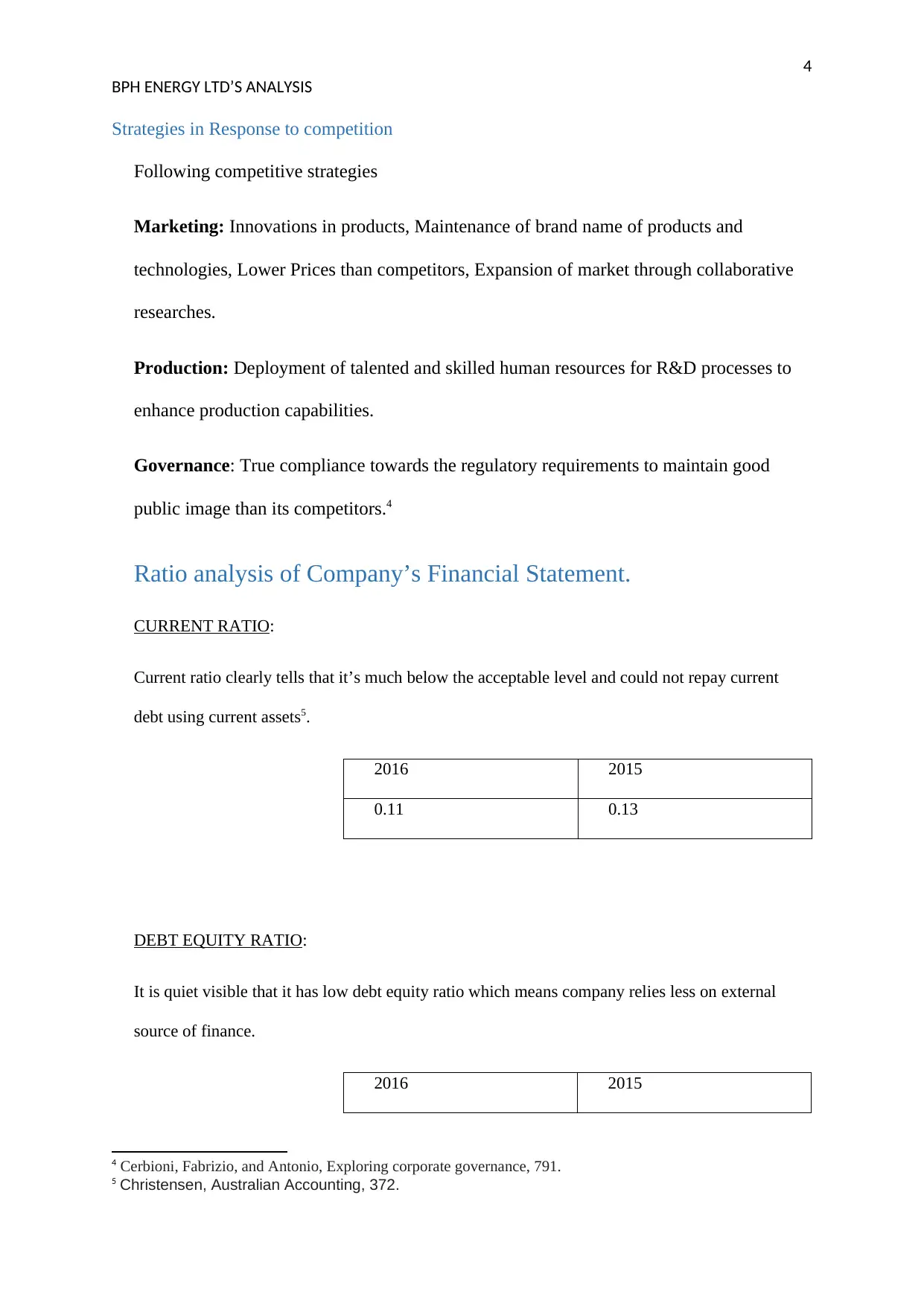
4
BPH ENERGY LTD’S ANALYSIS
Strategies in Response to competition
Following competitive strategies
Marketing: Innovations in products, Maintenance of brand name of products and
technologies, Lower Prices than competitors, Expansion of market through collaborative
researches.
Production: Deployment of talented and skilled human resources for R&D processes to
enhance production capabilities.
Governance: True compliance towards the regulatory requirements to maintain good
public image than its competitors.4
Ratio analysis of Company’s Financial Statement.
CURRENT RATIO:
Current ratio clearly tells that it’s much below the acceptable level and could not repay current
debt using current assets5.
2016 2015
0.11 0.13
DEBT EQUITY RATIO:
It is quiet visible that it has low debt equity ratio which means company relies less on external
source of finance.
2016 2015
4 Cerbioni, Fabrizio, and Antonio, Exploring corporate governance, 791.
5 Christensen, Australian Accounting, 372.
BPH ENERGY LTD’S ANALYSIS
Strategies in Response to competition
Following competitive strategies
Marketing: Innovations in products, Maintenance of brand name of products and
technologies, Lower Prices than competitors, Expansion of market through collaborative
researches.
Production: Deployment of talented and skilled human resources for R&D processes to
enhance production capabilities.
Governance: True compliance towards the regulatory requirements to maintain good
public image than its competitors.4
Ratio analysis of Company’s Financial Statement.
CURRENT RATIO:
Current ratio clearly tells that it’s much below the acceptable level and could not repay current
debt using current assets5.
2016 2015
0.11 0.13
DEBT EQUITY RATIO:
It is quiet visible that it has low debt equity ratio which means company relies less on external
source of finance.
2016 2015
4 Cerbioni, Fabrizio, and Antonio, Exploring corporate governance, 791.
5 Christensen, Australian Accounting, 372.
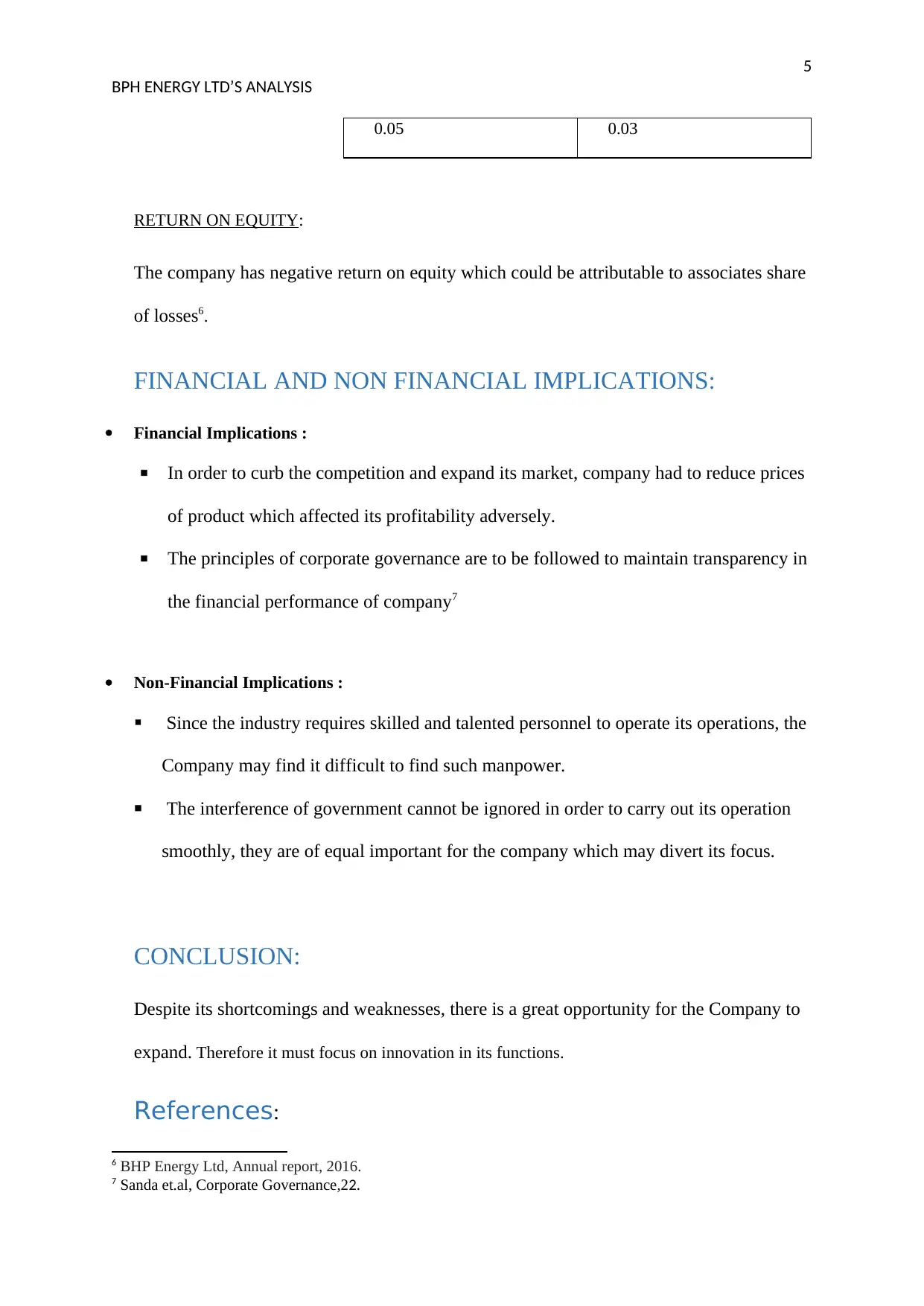
5
BPH ENERGY LTD’S ANALYSIS
0.05 0.03
RETURN ON EQUITY:
The company has negative return on equity which could be attributable to associates share
of losses6.
FINANCIAL AND NON FINANCIAL IMPLICATIONS:
Financial Implications :
In order to curb the competition and expand its market, company had to reduce prices
of product which affected its profitability adversely.
The principles of corporate governance are to be followed to maintain transparency in
the financial performance of company7
Non-Financial Implications :
Since the industry requires skilled and talented personnel to operate its operations, the
Company may find it difficult to find such manpower.
The interference of government cannot be ignored in order to carry out its operation
smoothly, they are of equal important for the company which may divert its focus.
CONCLUSION:
Despite its shortcomings and weaknesses, there is a great opportunity for the Company to
expand. Therefore it must focus on innovation in its functions.
References:
6 BHP Energy Ltd, Annual report, 2016.
7 Sanda et.al, Corporate Governance,22.
BPH ENERGY LTD’S ANALYSIS
0.05 0.03
RETURN ON EQUITY:
The company has negative return on equity which could be attributable to associates share
of losses6.
FINANCIAL AND NON FINANCIAL IMPLICATIONS:
Financial Implications :
In order to curb the competition and expand its market, company had to reduce prices
of product which affected its profitability adversely.
The principles of corporate governance are to be followed to maintain transparency in
the financial performance of company7
Non-Financial Implications :
Since the industry requires skilled and talented personnel to operate its operations, the
Company may find it difficult to find such manpower.
The interference of government cannot be ignored in order to carry out its operation
smoothly, they are of equal important for the company which may divert its focus.
CONCLUSION:
Despite its shortcomings and weaknesses, there is a great opportunity for the Company to
expand. Therefore it must focus on innovation in its functions.
References:
6 BHP Energy Ltd, Annual report, 2016.
7 Sanda et.al, Corporate Governance,22.
⊘ This is a preview!⊘
Do you want full access?
Subscribe today to unlock all pages.

Trusted by 1+ million students worldwide
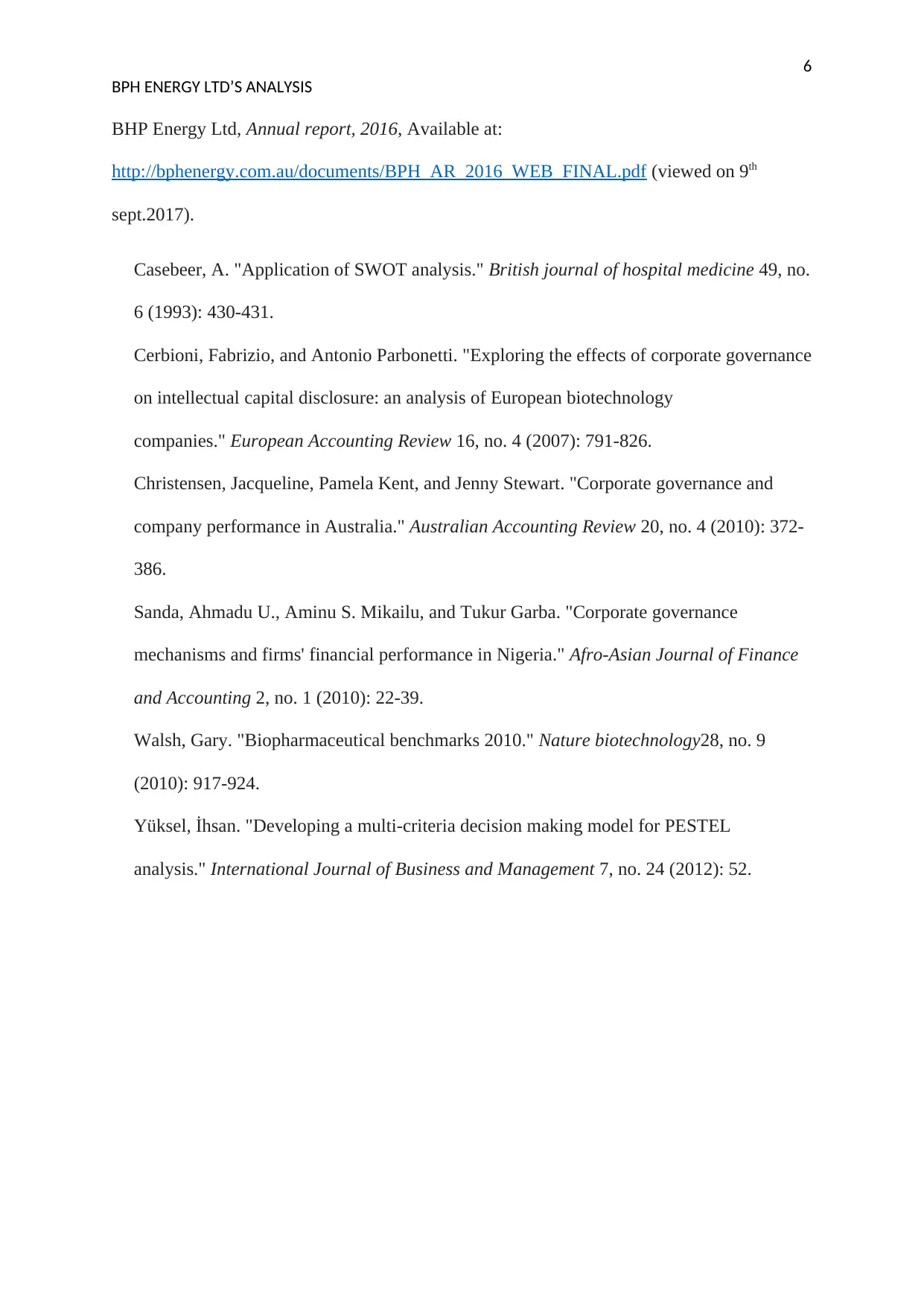
6
BPH ENERGY LTD’S ANALYSIS
BHP Energy Ltd, Annual report, 2016, Available at:
http://bphenergy.com.au/documents/BPH_AR_2016_WEB_FINAL.pdf (viewed on 9th
sept.2017).
Casebeer, A. "Application of SWOT analysis." British journal of hospital medicine 49, no.
6 (1993): 430-431.
Cerbioni, Fabrizio, and Antonio Parbonetti. "Exploring the effects of corporate governance
on intellectual capital disclosure: an analysis of European biotechnology
companies." European Accounting Review 16, no. 4 (2007): 791-826.
Christensen, Jacqueline, Pamela Kent, and Jenny Stewart. "Corporate governance and
company performance in Australia." Australian Accounting Review 20, no. 4 (2010): 372-
386.
Sanda, Ahmadu U., Aminu S. Mikailu, and Tukur Garba. "Corporate governance
mechanisms and firms' financial performance in Nigeria." Afro-Asian Journal of Finance
and Accounting 2, no. 1 (2010): 22-39.
Walsh, Gary. "Biopharmaceutical benchmarks 2010." Nature biotechnology28, no. 9
(2010): 917-924.
Yüksel, İhsan. "Developing a multi-criteria decision making model for PESTEL
analysis." International Journal of Business and Management 7, no. 24 (2012): 52.
BPH ENERGY LTD’S ANALYSIS
BHP Energy Ltd, Annual report, 2016, Available at:
http://bphenergy.com.au/documents/BPH_AR_2016_WEB_FINAL.pdf (viewed on 9th
sept.2017).
Casebeer, A. "Application of SWOT analysis." British journal of hospital medicine 49, no.
6 (1993): 430-431.
Cerbioni, Fabrizio, and Antonio Parbonetti. "Exploring the effects of corporate governance
on intellectual capital disclosure: an analysis of European biotechnology
companies." European Accounting Review 16, no. 4 (2007): 791-826.
Christensen, Jacqueline, Pamela Kent, and Jenny Stewart. "Corporate governance and
company performance in Australia." Australian Accounting Review 20, no. 4 (2010): 372-
386.
Sanda, Ahmadu U., Aminu S. Mikailu, and Tukur Garba. "Corporate governance
mechanisms and firms' financial performance in Nigeria." Afro-Asian Journal of Finance
and Accounting 2, no. 1 (2010): 22-39.
Walsh, Gary. "Biopharmaceutical benchmarks 2010." Nature biotechnology28, no. 9
(2010): 917-924.
Yüksel, İhsan. "Developing a multi-criteria decision making model for PESTEL
analysis." International Journal of Business and Management 7, no. 24 (2012): 52.
1 out of 7
Related Documents
Your All-in-One AI-Powered Toolkit for Academic Success.
+13062052269
info@desklib.com
Available 24*7 on WhatsApp / Email
![[object Object]](/_next/static/media/star-bottom.7253800d.svg)
Unlock your academic potential
Copyright © 2020–2025 A2Z Services. All Rights Reserved. Developed and managed by ZUCOL.





